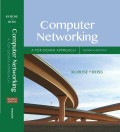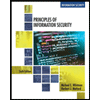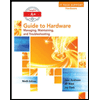
EBK COMPUTER NETWORKING
7th Edition
ISBN: 8220102955479
Author: Ross
Publisher: PEARSON
expand_more
expand_more
format_list_bulleted
Question
Chapter 9, Problem P15P
a)
Program Plan Intro
UDP:
UDP stands for User Data Protocol which is a communication protocol used for establishing low latency and loss tolerating connections between various applications on internet.
b)
Program Plan Intro
RTP (Real Time Protocol):
- It is a protocol that is used to provide end-to-end network transportation function for application to transmit the real time data.
- The real time data could be transmitting audio or video, simulated data or network services (unicast or multicast).
SIP (Session Initiation Protocol):
- It is a lightweight protocol which is used to establishing calls between the caller and the callee over an IP network.
- It is used to determine the current IP address of the callee to its caller.
- It is used in managing the call.
Expert Solution & Answer
Want to see the full answer?
Check out a sample textbook solution
Students have asked these similar questions
a. Suppose we send into the Internet two IP datagrams, each carrying a different UDP
segment. The first datagram has source IP address A1, destination IP address B, source
port P1, and destination port T. The second datagram has source IP address A2,
destination IP address B, source port P2, and destination port T. Suppose that A1 is
different from A2 and that P1 is different from P2. Assuming that both datagrams reach
their final destination, will the two UDP datagrams be received by the same socket? Why
or why not?
b. Suppose Alice, Bob, and Claire want to have an audio conference call using SIP and
RTP. For Alice to send and receive RTP packets to and from Bob and Claire, is only one
UDP socket sufficient (in addition to the socket needed for the SIP messages)? If yes,
then how does Alice's SIP client distinguish between the RTP packets received from Bob
and Claire?
Host A and B are communicating over a TCP connection, and Host B has already received from A all bytes up through byte 126. Suppose Host A then sends two segments to Host B backto-back. The first and second segments contain 80 and 40 bytes of data, respectively. In the first segment, the sequence number is 127, the source port number is 302, and the destination port number is 80. Host B sends an acknowledgment whenever it receives a segment from Host A.
d. Suppose the two segments sent by A arrive in order at B. The first acknowledgment is lost and the second acknowledgment arrives after the first timeout interval. Draw a timing diagram, showing these segments and all other segments and acknowledgments sent. (Assume there is no additional packet loss.) For each segment in your figure, provide the sequence number and the number of bytes of data; for each acknowledgment that you add, provide the acknowledgment number.
Host A and B are communicating over a TCP connection, and Host B has
already received all bytes up through byte 100 (including Byte 100) from A. Suppose
Host A then sends two packets to Host B back-to-back. The first and second packets
contain 40 and 80 bytes of data, respectively. Host B sends an acknowledgment
whenever it receives a packet from Host A.
a. What is the sequence number of the first packet sent from Host A to Host B? What is
the sequence number of the second packet sent from Host A to Host B?
b. If the second packet arrives before the first packet, in the acknowledgment of the
first arriving packet, what is the acknowledgment number? .
Chapter 9 Solutions
EBK COMPUTER NETWORKING
Ch. 9 - Prob. R1RQCh. 9 - Prob. R2RQCh. 9 - Prob. R3RQCh. 9 - Prob. R4RQCh. 9 - Prob. R5RQCh. 9 - Prob. R6RQCh. 9 - Prob. R7RQCh. 9 - Prob. R8RQCh. 9 - Prob. R9RQCh. 9 - Prob. R10RQ
Ch. 9 - Prob. R11RQCh. 9 - Prob. R12RQCh. 9 - Prob. R13RQCh. 9 - Prob. P1PCh. 9 - Prob. P2PCh. 9 - Prob. P3PCh. 9 - Prob. P4PCh. 9 - Prob. P5PCh. 9 - Prob. P6PCh. 9 - Prob. P7PCh. 9 - Prob. P8PCh. 9 - Prob. P9PCh. 9 - Prob. P10PCh. 9 - Prob. P11PCh. 9 - Prob. P12PCh. 9 - Prob. P13PCh. 9 - Prob. P14PCh. 9 - Prob. P15PCh. 9 - Prob. P16PCh. 9 - Prob. P17PCh. 9 - Prob. P18PCh. 9 - Prob. P19PCh. 9 - Prob. P20PCh. 9 - Prob. P21PCh. 9 - Prob. P22P
Knowledge Booster
Similar questions
- Consider two hosts P and Q connected through a router R. The maximum transfer unit (MTU) value of the link between Pand Ris 1500 bytes, and between Rand Qis 820 bytes. A TCP segment of size 1400 bytes was transferred from P to Q through R, with IP identification value as 0x1234. Assume that the IP header size is 20 bytes. Further, the packet is allowed to be fragmented, i.e., Don't Fragment (DF) flag in the IP header is not set by P, Which of the following statements is/are correct? (a) Two fragments are created at R and the IP datagram size carrying the second fragment is 620 bytes. (b) If the second fragment is lost, P is required to resend the whole TCP segment. (c) TCP destination port can be determined by analysing only the second fragment. (d) If the second fragment is lost, R will resend the fragment with the IP identification value 0x1234arrow_forwardHost A and B are communicating over a TCP connection, and Host B has already received from A all bytes up through byte 126. Suppose Host A then sends two segments to Host B backto-back. The first and second segments contain 80 and 40 bytes of data, respectively. In the first segment, the sequence number is 127, the source port number is 302, and the destination port number is 80. Host B sends an acknowledgment whenever it receives a segment from Host A.a. In the second segment sent from Host A to B, what are the sequence number, source port number, and destination port number?b. If the first segment arrives before the second segment, in the acknowledgment of the first arriving segment, what is the acknowledgment number, the source port number, and the destination port number?c. If the second segment arrives before the first segment, in the acknowledgment of the first arriving segment, what is the acknowledgment number?d. Suppose the two segments sent by A arrive in order at B. The…arrow_forwardHost A and B are communicating over a TCP connection. Host B has already received from Host A all bytes up through byte 23. Suppose Host A then sends two segments to Host B back-to-back. The first and the second segments contain 30 and 50 bytes of data, respectively. In the first segment, the sequence number is 24, the source port number is 3000, and the destination port number is 80. Host B sends an acknowledgment whenever it receives a segment from Host A. A. In the second segment sent from Host A to B, what arethe sequence number_________,source port number __________,and destination port number__________?B. If the second segment arrives after the first segment, in the acknowledgment of the second segment, what arethe acknowledgment number___________,the source port number__________,and the destination port number __________?C. If the second segment arrives before the first segment, in the acknowledgment of the first arriving segment,what is the acknowledgment number ___________?D.…arrow_forward
- P27. Host A and B are communicating over a TCP connection, and Host B has already received from A all bytes up through byte 126. Suppose Host A then sends two segments to Host B back-to-back. The first and second segments contain 80 and 40 bytes of data, respectively. In the first segment, the sequence number is 127, the source port number is 302, and the destination port number is 80. Host B sends an acknowledgment whenever it receives a segment from Host A. In the second segment sent from Host A to B, what are the sequence number, source port number, and destination port number? If the first segment arrives before the second segment, in the acknowledgment of the first arriving segment, what is the acknowledgment number, the source port number, and the destination port number? If the second segment arrives before the first segment, in the acknowledgment of the first arriving segment, what is the acknowledgment number? Suppose the two segments sent by A arrive in order at B.…arrow_forwardHost A and B are communicating over a TCP connection, and Host B has already received from A all bytes up through byte 126. Suppose Host A then sends two segments to Host B back-to-back. The first and second segments contain 80 and 40 bytes of data, respectively. In the first segment, the sequence number is 127, the source port number is 302, and the destination port number is 80. Host B sends an acknowledgment whenever it receives a segment from Host A. a. In the second segment sent from Host A to B, what are the sequence number, source port number, and destination port number? b. If the first segment arrives before the second segment, in the acknowledgment of the first arriving segment, what is the acknowledgment number, the source port number, and the destination port number? c. If the second segment arrives before the first segment, in the acknowledgment of the first arriving segment, what is the acknowledgment number? d. Suppose the two segments sent by A arrive in order at B. The…arrow_forwardA 3200 bit long TCP message is transmitted to the IP layer and becomes a datagram after adding a 160 bit header. The following Internet is connected by two LANs through routers. But the data part of the longest data frame that the second LAN can transmit is only 1200 bits. Therefore, datagrams must be segmented in the router. How many bits of data does the second LAN transmit to its upper layer?arrow_forward
- In IPV4, consider sending a 4,000 byte datagram (20 bytes of IP header) into a link that has an MTU of 1,500 bytes. The datagram will be allocated to fragments, and the offset value of the third segment is 3, 370 3, 185 4, 185 4, 370arrow_forward1. What is the difference between packet fragmentation (i.e., at network layer) and frame frag- mentation (i.e., at link layer) in terms of purpose? 2. Suppose that host A is connected to a router R1, R1 is connected to another router, R2, and R2 is connected to host B. Suppose that a TCP message that contains 800 bytes of data and 20 bytes of TCP header is passed to the IP function at host A for delivery to B. Show the Total length, DF, MF, and Fragment offset fields of the IP header in each packet transmitted over the three links. (Assume that link A-R1 can support a maximum frame size of 1024 bytes including a 14-byte frame header, link R1-R2 can support a maximum frame size of 512 bytes, including an 8-byte frame header, and link R2-B can support a maximum frame size of 432 bytes including a 12-byte frame header.) (*hint: the Fragment offset field is denominated by 8-bytes, not bytes) 3. What is the purpose of the path MTU discovery process (see textbook Figure 5-42) and why does…arrow_forwardProvide short answers to the following: How do you determine whether an IP address is a multicast address? What is the TTL field in the IP header used for? What is the maximum length of options bytes that can be carried in an IPv4 header? Why do we have to multiply the offset field of an IP datagram by eight to obtain the real offset for the first byte of the datagram?arrow_forward
- Suppose Host A sends two consecutive TCP segments to Host B over a TCP connection. The sequence number of the first segment is 748, and the sequence number of the second one is 995. Determine the size of the payload carried by the first segment. Suppose that the first segment is lost but the second segment arrives at host B. What will be the acknowledgment number of the acknowledgment segment that Host B sends to Host A?arrow_forwardSuppose Host A sends two consecutive TCP segments to Host B over a TCP connection. The sequence number of the first segment is 748, and the sequence number of the second one is 995. Determine the size of the payload carried by the first segment.Suppose that the first segment is lost but the second segment arrives at host B. What will be the acknowledgment number of the acknowledgment segment that Host B sends to Host A?arrow_forward- Suppose a TCP message that contains 1024 bytes of data and 20 bytes of TCP header is passed to IP for delivery across two networks interconnected by a router (i.e., it travels from the source host to a router to the destination host). The first network has an MTU of 1024 bytes; the second has an MTU of 576 bytes. Each network's MTU gives the size of the largest IP datagram that can be carried in a link-layer frame. Give the sizes and offsets of the sequence of fragments delivered to the network layer at the destination host. Assume all IP headers are 20 bytes.arrow_forward
arrow_back_ios
SEE MORE QUESTIONS
arrow_forward_ios
Recommended textbooks for you
 A+ Guide To It Technical SupportComputer ScienceISBN:9780357108291Author:ANDREWS, Jean.Publisher:Cengage,
A+ Guide To It Technical SupportComputer ScienceISBN:9780357108291Author:ANDREWS, Jean.Publisher:Cengage, Principles of Information Security (MindTap Cours...Computer ScienceISBN:9781337102063Author:Michael E. Whitman, Herbert J. MattordPublisher:Cengage Learning
Principles of Information Security (MindTap Cours...Computer ScienceISBN:9781337102063Author:Michael E. Whitman, Herbert J. MattordPublisher:Cengage Learning A+ Guide to Hardware (Standalone Book) (MindTap C...Computer ScienceISBN:9781305266452Author:Jean AndrewsPublisher:Cengage Learning
A+ Guide to Hardware (Standalone Book) (MindTap C...Computer ScienceISBN:9781305266452Author:Jean AndrewsPublisher:Cengage Learning Systems ArchitectureComputer ScienceISBN:9781305080195Author:Stephen D. BurdPublisher:Cengage Learning
Systems ArchitectureComputer ScienceISBN:9781305080195Author:Stephen D. BurdPublisher:Cengage Learning

A+ Guide To It Technical Support
Computer Science
ISBN:9780357108291
Author:ANDREWS, Jean.
Publisher:Cengage,

Principles of Information Security (MindTap Cours...
Computer Science
ISBN:9781337102063
Author:Michael E. Whitman, Herbert J. Mattord
Publisher:Cengage Learning

A+ Guide to Hardware (Standalone Book) (MindTap C...
Computer Science
ISBN:9781305266452
Author:Jean Andrews
Publisher:Cengage Learning

Systems Architecture
Computer Science
ISBN:9781305080195
Author:Stephen D. Burd
Publisher:Cengage Learning